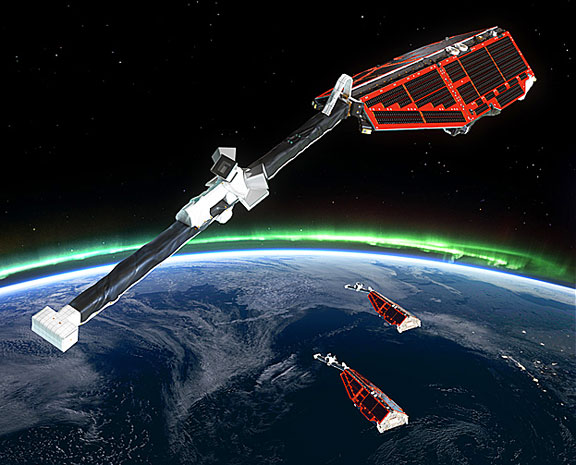....a series of environmental tests designed to demonstrate their fitness for space flight. The purpose of the Swarm mission is to analyze, in unprecedented detail, the geomagnetic field and its evolution over time. The results of the mission will help to improve our understanding of the Earth’s interior and climate. The trio of satellites is due to be launched from Russia’s Plesetsk Cosmodrome in July 2012. Astrium—selected by the European Space Agency (ESA) as the prime contractor for the Swarm mission—is currently carrying out further extensive functional checks on the satellites at its supplier’s IABG test facility near Munich, in Germany. Preparations for the launch are scheduled to start in May, when the three satellites will be shipped to Russia. All three satellites will be launched simultaneously from the Plesetsk Cosmodrome (around 800 kilometres northeast of Moscow) on a single Rockot launch vehicle.
Scientists hope that the three identical Swarm satellites will provide the most accurate survey to date of the geomagnetic field and record any changes that occur. Swarm will, in a manner of speaking, follow in the footsteps of Jules Verne’s novel ‘Journey to the Centre of the Earth’. Today, however, it is no longer necessary to dig tunnels or drill holes to take a closer look at the composition of the Earth’s interior. Thanks to the development of ‘satellite remote sensing’, Swarm can achieve this goal from orbit. The Earth’s gravitational and magnetic fields offer direct insights into the workings of its interior: from the variations these fields display at different times and places, scientists can draw conclusions about the dynamic processes taking place beneath the planet’s surface.
Extremely accurate, high-resolution readings of the geomagnetic field’s strength, orientation and fluctuations, complemented by precise navigation and velocity data, along with measurements of the electric field intensity, will provide the observational data required to distinguish between the various sources of the geomagnetic field and to explain them through models. Observation of these aspects from space offers a unique opportunity to take a closer look both at the composition of the interior of our planet and at the processes at work there. The mission will also enable scientists to analyze the Sun’s influence on the Earth. Furthermore, improvements in our knowledge of the geomagnetic field are expected to provide benefits of a practical nature, such as more accurate navigation for ships and aircraft, the discovery and access of natural resources below the Earth’s surface, a better understanding of the impact of the Sun on the Earth’s meteorological cycles, and timely warnings of dangerous radiation.

Three satellites will comprise the ESA's Swarm magnetic field mission.
The satellites will be launched into a polar orbit at an altitude of 490 kilometres. After four years, two of the satellites will be steered into a lower orbit, circling the Earth in tandem at a height of 300 kilometres. The course of the third, higher-orbiting satellite will then be altered to cross the path of the two satellites in the lower orbit at an angle of 90 degrees.

